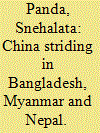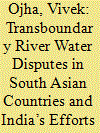| Srl | Item |
| 1 |
ID:
164072


|
|
|
|
|
| Summary/Abstract |
China has pulled into its orbit relatively poor South Asian countries like Bangladesh, Myanmar and Nepal by extensive economic support and investments in infrastructure development. Bangladesh and Myanmar are important for accessing strategically located ports which will provide it alternative sea routes for unimpeded trade and commerce. Nepal is important to tighten its border with Tibet. Moreover, it is a cleverly planned strategy to access their market, supply military equipment and eclipse India’s influence in these countries. But it is no cakewalk as big international powers are countering China through diplomatic and economic means to constrict its growing influence in South Asia. The local communities are averse to its aid and investment as they apprehend that the projects are intended to benefit the investor and endanger their livelihood as well as environment while governments in each of these countries are striving to balance their relationship with big powers.
|
|
|
|
|
|
|
|
|
|
|
|
|
|
|
|
| 2 |
ID:
178831


|
|
|
|
|
| Summary/Abstract |
This study scrutinizes the impact of globalization, non-renewable energy consumption, and economic growth on CO2 emission for selected South Asian economies during 1985–2018 under the EKC framework. For this purpose, we apply a fully modified ordinary least square (FMOLS) technique. The empirical findings of this study identify that globalization is positively associated with CO2 emission. The results also indicate that non-renewable energy consumption increasing environmental pollution. Moreover, the results confirm the EKC hypothesis in the South Asian region; this means that at the early stages of development, when economic growth increases, environmental pollution also increases, but environmental degradation starts to decrease with the increases in economic growth after the threshold point. The empirical outcomes suggest that the government should subsidize and promote renewable energy sources to tackle the problem of environmental degradation.
|
|
|
|
|
|
|
|
|
|
|
|
|
|
|
|
| 3 |
ID:
129716


|
|
|
|
|
| Publication |
2014.
|
| Summary/Abstract |
The political landscape of South Asia has changed completely because of the formation of new governments in most of the South Asian countries. India, one of the important players in the region is going to have its general elections held in March-April 2014. China also underwent change in its leadership in 2013. Recent years have seen increased competition and repeated rivalries between China and India over the issue of their engagements with South Asian countries. China in this paper is treated as part of South Asia itself as it has over period of last few decades succeeded in connecting itself with this region through well built highways and rail-network, which has enabled China to have unrestricted access towards Arabian Sea, Bay of Bengal and Indian Ocean.
|
|
|
|
|
|
|
|
|
|
|
|
|
|
|
|
| 4 |
ID:
107554


|
|
|
|
|
| Publication |
2011.
|
| Summary/Abstract |
Despite the large number and variety of studies addressing the relationship between military spending and economic growth, a consensus regarding the exact nature of any relationship between the two has proven elusive. This study uses a panel co-integration approach to examine the relationship between military spending and economic growth in the five South Asian countries of India, Pakistan, Nepal, Sri Lanka and Bangladesh over the period of 1988-2007. It finds that a 1% increase in military spending increases real GDP by only 0.04%, suggesting that the substantial amount of public expenditure that is currently directed towards military purposes in these countries has a negligible impact upon economic growth.
|
|
|
|
|
|
|
|
|
|
|
|
|
|
|
|
| 5 |
ID:
086927


|
|
|
|
|
| Publication |
2009.
|
| Summary/Abstract |
Is the foreign media portraying a skewed image of Pakistan or are they simply reporting the reality?
|
|
|
|
|
|
|
|
|
|
|
|
|
|
|
|
| 6 |
ID:
179653


|
|
|
|
|
| Summary/Abstract |
Water in 21st century has been called the ‘next oil’. In the coming decades, the supply of water has the potential to influence geopolitics, diplomacy and even conflict. Water resource politics in south asia has become strong tool to exert pressure by several countries in order to attain their vested interests. Everyone knows that China , Pakistan , Nepal and Bangladesh and India are involved in multiple river water disputes at varying levels.
|
|
|
|
|
|
|
|
|
|
|
|
|
|
|
|